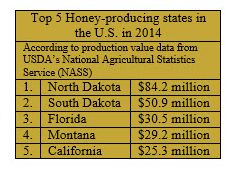WASHINGTON, April 8, 2015 – Domestic honey producers are abuzz with concerns about the role imported honey from China could be playing in their market, and Capitol Hill is starting to take notice.
Honey from China has been making its way into the U.S. for some time now, bringing a host of economic and food safety concerns with it. Worries about antibiotic residues and China’s attempts to skirt tariffs have all been voiced by the U.S. honey industry, leading Senate Agriculture Committee member Bob Casey, D-Pa., to call on the FDA for a federal standard of honey identification.
“It’s simply unacceptable that countries like China continue to cheat the system. China’s cheating, whether it’s smuggling honey or manipulating currency, has a serious impact on jobs and economic growth in Pennsylvania,” Casey said in a release. In March, Casey sent a letter calling for the standard to then FDA Commissioner Margaret Hamburg, citing a U.S. Immigration and Customs Enforcement announcement that $2.45 million worth of “illegally imported Chinese honey” was seized between October 2014 and January 2015.
According to USDA figures, the U.S. produced more than $385 million worth of honey in 2014, an increase of about $65 million from 2013. Honey prices increased to a record high during 2014 to 216.1 cents per pound, up 1 percent from 214.1 cents per pound in 2013 and producers responded. Honey production in 2014 from producers with five or more colonies totaled 178 million pounds, up 19 percent from 2013. There were 2.74 million colonies producing honey in 2014, up 4 percent from 2013. Yield per colony averaged 65.1 pounds, up 15 percent from the 56.6 pounds in 2013.

When Chinese honey enters the U.S. market, it is typically “well below the cost of production” in the U.S. according to Mark Mammen, executive vice president of Sue Bee Honey, a honey packer in Sioux City, Iowa, that markets its honey as a “product of the USA.”
The quality of Chinese honey is also suspect. In 2003, chloramphenicol, an antibiotic that has been disallowed in food animals, was found in imported Chinese honey. Concerns about antibiotic residues were also present in the 1990s, according to Bill Huser, Sue Bee’s vice president of research and development.
In some cases, water, starches or plant-based syrups such as high-fructose corn syrup has been added to Chinese honey to increase volume, Huser said. That means the product is no longer 100 percent pure and it can behave and taste differently in some cooking applications.
China has also been found to be shipping its honey – which faces anti-dumping duties of over 200 percent imposed in 2006 – into the U.S. though countries such as Malaysia, whose products have a smaller import duty.
In an interview with Agri-Pulse, Huser said the perception and financial issues created by illegal Chinese honey create a “continual battle” for the domestic industry.
“We have enough concern here domestically with declining bee populations, declining forage areas, and some agricultural practices . . . that are hard on the bees,” Huser said, citing decreased acres enrolled in the Conservation Reserve Program as an example. “That’s big enough problems without having to worry about import honey.”
While the industry takes issue with illegal Chinese honey in the market, American consumers are currently using more honey than the domestic industry can produce. As the industry – and agriculture as a whole – deals with bee shortages, Margaret Lombard, CEO of the National Honey Board, said it is important not to lump all imports together.
“Not all foreign honey is bad,” Lombard said in an interview with Agri-Pulse. “There’s a lot of beautiful honey that’s being produced all over the world that is imported that’s not negative, so there are a few bad players out there as there are in every industry.”
Mammen agrees, adding that U.S. honey consumption has gone up “pretty dramatically” in the last 15 years. “So there is a need for offshore honey into the U.S. to meet demand, but we just want to make sure that it’s not dumped honey at low prices and it meets quality standards.”
[This article first appeared in our April 8, 2015 Agri-Pulse newsletter. If you aren’t a subscriber or don’t download our Wednesday newsletters, you’re missing out on stories such as this one.]
#30
For more news, go to www.agri-pulse.com.

